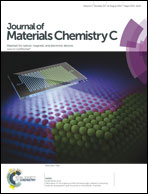Fabrication of homogenous three dimensionally ordered conducting polymer–polystyrene opal structures in microfluidic channels
Abstract
A chemical polymerisation method for fabricating an electrochemically addressable, three dimensionally (3-D) ordered homogenous polyaniline (PANI)-based opal structure in a microfluidic channel is described. Electrochemical polymerisation was also explored as a route to creating opal structures of PANI. Interestingly, electrochemical growth resulted in an inhomogeneous gradient-type morphology throughout the depth of the template leading to non-uniform 3-D PANI structures. Using the chemical polymerisation approach, a thin coating of PANI could be deposited homogeneously to the polystyrene (PS) sphere surfaces. This coating was electrochemically accessible subsequent to an electrochemical polymerisation step electrically connecting the channel-based opal structure to an integrated gold working electrode within the microchannel. Electrochemical characterisation of the resultant ordered PANI–PS material in-channel, demonstrated the synthesis of a well behaved, stable PANI coating throughout the PS colloidal crystal (CC) which behaves as a thin film with fast electron transfer.


 Please wait while we load your content...
Please wait while we load your content...